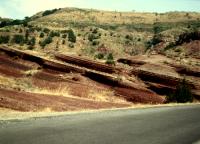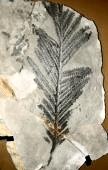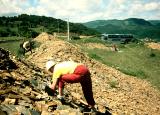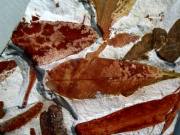A concise report of the development of the flora
III. Permian - Early Cretaceous |
 I.
Silurian and Devonian I.
Silurian and Devonian II. Carboniferous and Early Permian IV. Cretaceous - present |
 In
the Early Permian circumstances changed. It was
getting hotter and dryer and as a consequence large areas turned into
desert. The red colour of many soils, formed in this period, reflects the
hot, dry climate. Click on the photo on the left. This development
is related to the fact that all continents were slowly drifted together and
formed one supercontinent
(Pangea).
This caused an enormous inner land with an extreme and arid climate. That
is the reason why many plant species which could resist heat and aridity
came into existance. And animal predation! For amphibians and
reptiles, being the masters of the continents at that time, consumed everything
they met and as a reaction plants developed different defences like thorns
and poison.
In
the Early Permian circumstances changed. It was
getting hotter and dryer and as a consequence large areas turned into
desert. The red colour of many soils, formed in this period, reflects the
hot, dry climate. Click on the photo on the left. This development
is related to the fact that all continents were slowly drifted together and
formed one supercontinent
(Pangea).
This caused an enormous inner land with an extreme and arid climate. That
is the reason why many plant species which could resist heat and aridity
came into existance. And animal predation! For amphibians and
reptiles, being the masters of the continents at that time, consumed everything
they met and as a reaction plants developed different defences like thorns
and poison.
The division in Paleozoic, Mesozoic and Kenozoic cannot in fact be used for plants. There is an other one for the development of the flora: Paleophytic (Silurian - Early Permian), Mesophytic (Early Permian - Jurassic) and Kenophytic (Early Cretaceous - present). See scheme.
 |
The seed ferns were still going strong, even until the Jurassic. Many groups disappeared but they were replaced by other ones. In a quarry near Lodève in France (click photo on the right) many fossil plants from the Lower Permian have been found. Their preservation however is not as good as those from the coal swamps. The reason is that these plants were transported from other places by rivers and this transport often caused heavy damage to the plants. Click on the photo on the left to see some fossils of seed ferns. Click here for extensive information on the quarry of Lodève. |  |
The clubmoss trees and the horsetail trees disappeared gradually and became extinct during the Permian. The herbal clubmosses and horsetails however lived on, but as a kind of relics of groups which were much more successful in earlier times.
 |
The southern part of the supercontinent Pangea, composed of Africa,
Australia, Antarctica and India, is called
Gondwana
or Gondwanaland. During the Permian a specific flora evolved here, which
has not yet been understood completely. The plants are indicated as
Glossopteris and most probably they were seed ferns. But other
plants could be included as well. Glossopteris plants were trees with elongated leaves with reticulate veins. On the leaves are sometimes fructifications. During the Triassic there were still Glossopteris plants, but after that they became extinct. Click on the photo on the left to see some leaves. |
At the end of the Permian the greatest extinction of all times
took place, meaning the end of 95% of all animal species. The damage in the
flora was less extensive, although also many plant species disappeared, but
they were soon replaced by other species. As for the plants the Permian passed
rather smoothly into the Triassic.
Plant fossils from the Permian are found (among other places) in Germany
in Rheinland/Pfalz near Sobernheim, and also in Thüringen near Manebach.
Furthermore in France near Lodève.
In the warm Jurassic period flora and fauna came to full prosperity again. The growing conditions were very good all over the Earth and an abundant vegetation developed. The looks of the forests had become totally different from those of the Carboniferous. Now the gymnosperms were dominating.
In the Early Jurassic some seed ferns still existed, but later on they died out. The real ferns formed an important element of the Jurassic flora. There were tree ferns as well as herbal ferns. Several groups, living in the Jurassic, have still representatives in de modern flora, but the species are of course different. All Jurassic species have become extinct.